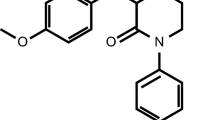Abstract
Background: Electrical cardioversion of atrial fibrillation (AF) is associated with a thromboembolic risk, and this risk can be reduced by the use of antithrombotic therapy. International guidelines recommend an effective oral anticoagulant therapy (OAT) for at least 3 weeks before, and 4 weeks after cardioversion. We studied whether electrical cardioversion in it self causes changes in the level of activity in the haemostatic system during treatment with either low-molecular-weight heparin (LMWH).
Methods: Thirty-eight patients with AF were randomised consecutively to either LMWH administered subcutaneous in a fixed daily dose, or conventional OAT. Changes in the biochemical markers prothrombin fragment 1+2 (F1+2), D-Dimer, and soluble fibrin, all reflecting the activity in the haemostatic system, were assessed at baseline, before and after electrical cardioversion in patients treated with LMWH for 3 weeks prior to cardioversion. A follow up compared the time spent on antiocoagulation prior to cardioversion, and eventual complications in the two group (LMWH vs. OAT).
Results and conclusions: No significant differences between the levels of the biochemical markers measured before, and after cardioversion were seen, indicating that during anticoagulant therapy with LMWH, electrical cardioversion in itself, does not cause an increased activity in the haemostatic system. Also the level of F1+2 had declined significantly after cardioversion, when compared to baseline level in patients, whom had a normal sinus rhythm (NSR) re-established. This indicates that even in patients on a stable anticoagulant treatment, restoration of a NSR can cause a further decrease in thrombin generation.
The median time spent on antithrombotic treatment prior to cardioversion, was significantly different between the LMWH (27 days) and the OAT group (138 days). Our study indicates that cardioversion in patients on LMWH does not cause a hypercoagulable state and that LMWH significantly shortens the time spent on anticoagulant therapy prior to cardioversion.
Similar content being viewed by others
References
Wolf PA, Abbott RD, Kannel WB. Atrial fibrillation as an independent risk factor for stroke: The Framingham Study. Stroke 1991;22:983–988.
Atrial fibrillation Investigators. Risk factors for stroke and efficacy of antithrombotic therapy in atrial fibrillation. Analysis of pooled data from five randomized controlled trials. Arch Intern Med 1994;154:1449–1457.
Kinch JW, Davidoff R. Prevention of embolic events after cardioversion of atrial fibrillation. Current and evolving strategies. Arch Intern Med 1995;155:1353–1360.
Bjerkelund CJ, Orning OM. The efficacy of anticoagulant therapy in preventing embolism related to D.C. electrical conversion of atrial fibrillation. AmJ Cardiol 1969;23:208–216.
Laupacis A, Albers GW, Dalen JE, Dunn MI, Jacobsen AK, Singer DE. Antithrombotic therapy in atrial fibrillation. Chest 1998;114:579S–589S.
Lévy S, Breithardt G, Campbell RWF, et al. Atrial fibril-lation: Current knowledge and recommendations for management. Eur Heart J 1998;19:1294–1320.
Godtfredsen J, Sandbjerg Hansen M, Husted SE, Hjelms E, Jespersen J. Antitrombotisk behandling ved kardio-vaskulære sygdomme. En klaringsrapport. Ugeskr Læger 1997;159:1–28.
Klein AL, Grimm RA, Murray DR, et al. Use of transesophageal echocardiography to guide cardiover-sion in patients with atrial fibrillation. N Engl J Med 2001;344:1411–1420.
Asakura H, Hifumi S, Jokaji H, et al. Prothrombin fragment F1+2 and thrombin-antithrombin III complex are useful markers of the hypercoagulable state in atrial fibrillation. Blood Coagul Fibrinolysis 1992;3:469–473.
Lip GYH, Lowe GDO, Rumley A, Dunn FG. Increased markers of thrombogenesis in chronic atrial fibrillation: Effects of warfarin treatment. Br Heart J 1995;73:527–533.
Lip GYH, Rumley A, Dunn FG, Lowe GDO. Plasma fibrinogen and fibrin D-dimer in patients with atrial fibrilla-tion: Effects of cardioversion to sinus rhythm. Int J Cardiol 1995;51:245–251.
Feinberg WM, Pearce LA, Hart RG, et al. Markers of thrombin and platelet activity in patients with atrial fibrillation: Correlation with stroke among 1531 participants in the stroke prevention in atrial fibrillation III study. Stroke 1999;30:2547–2553.
Feng D, D'Agostino RB, Silbershatz H, et al. Hemostatic state and atrial fibrillation (The Framingham Offspring Study). Am J Cardiol 2001;87:168–171.
Teitel JM, Bauer KA, Lau HK, Rosenberg RD. Studies of the prothrombin activation pathway utilizing radioim-munoassay for the F2/F1 +2 fragment and thrombin-antithrombin complex. Blood 1982;59:1086–1097.
Lip GYH, Lowe GDO. Fibrin D-dimer: A useful marker of thrombogenesis. Clin Sci 1995;89:205–214.
Brodsky MA, Allen BJ, Capparelli EV, Luckett CR, Morton R, Henry WL. Factors determining maintenance of sinus rhythm after chronic atrial fibrillation with left atrial di-latation. Am J Cardiol 1989;63:1065–1068.
Wyse DG, Waldo AL, DiMarco JP, et al. A comparison of rate control and rhythm control in patients with atrial fibrillation. N Engl J Med 2002;347:1825–1833.
Van Gelder IC, Hagens VE, Bosker HA, et al. A comparison of rate control and rhythm control in patients with recurrent persistent atrial fibrillation. N Engl J Med 2002;347:1834–1840.
Hagens VE, Ranchor AV, Van Sonderen E, et al. Effect of rate or rhythm control on quality of life in persistent atrial fibrillation. Results from the Rate Control Versus Electrical Cardioversion (RACE) Study. J AmColl Cardiol 2004;43:241–247.
Grimm RA, Stewart WJ, Maloney JD, et al. Impact of electrical cardioversion for atrial fibrillation on left atrial appendage function and spontaneous echo contrast: Characterization by simultaneous transesophageal echocardiography. J AmColl Cardiol 1993;22:1359–1366.
Giansante C, Fiotti N, Miccio M, Altamura N, Salvi R, Guarnieri G. Coagulation indicators in patients with paroxysmal atrial fibrillation: Effects of electric and phar-macologic cardioversion [see comments]. Am Heart J 2000;140:423–429.
Oltrona L, Broccolino M, Merlini PA, Spinola A, Pezzano A, Mannucci PM. Activation of the hemostatic mechanism after pharmacological cardioversion of acute nonvalvular atrial fibrillation. Circulation 1997;95:2003–2006.
Author information
Authors and Affiliations
Rights and permissions
About this article
Cite this article
Zeuthen, E.L., Lassen, J.F. & Husted, S.E. Haemostatic Activity in Patients with Atrial Fibrillation Treated with Low-Molecular-Weight Heparin Before and After Electrical Cardioversion. J Thromb Thrombolysis 17, 185–189 (2004). https://doi.org/10.1023/B:THRO.0000040487.25109.ad
Issue Date:
DOI: https://doi.org/10.1023/B:THRO.0000040487.25109.ad




